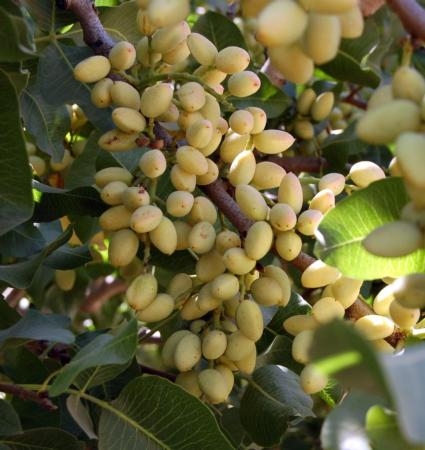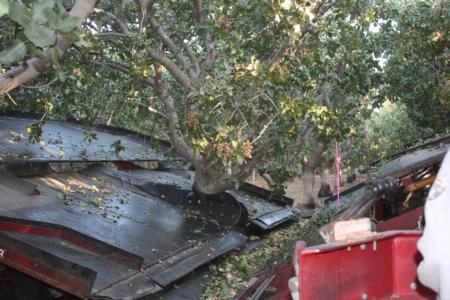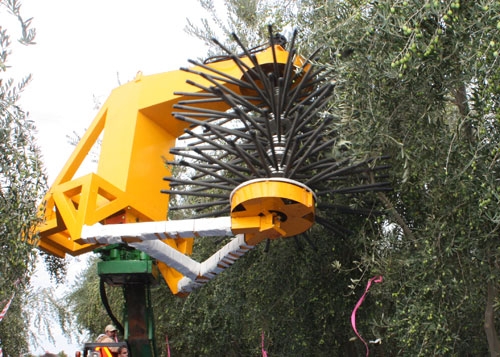Pistachio harvest: Wait, split, GO!
“Pistachio is a funny kind of nut,” says UC pomologist Louise Ferguson. With other nuts, the shell grows and hardens as the kernel develops, whereas pistachio grows its shell first, hardens it, and then plumps up a kernel inside. As early perhaps as Labor Day, when growers are always hopeful the harvest can begin, it will be seen whether the nuts in the millions of trees in California orchards have formed well.
Tension is rising. In these last hot days of August, as the nuts reach maturity, the shells must split. If too many of them don’t, the harvest will be much less profitable, because it’s hard to make a natural-looking split in a pistachio shell with a machine, and unsplit pistachios bring a lower return. Growers are watching the split percentages carefully; wait too long for the highest number and navel orange worms have a larger window of opportunity to lay eggs along the sutures.
Pistachio orchards are harvested mechanically, and the machines are generally owned by contractors, though a large farm may have its own. As soon as the first machine enters the first orchard — the greatest acreage is on the west side of the San Joaquin Valley, around Bakersfield — a race begins.
“It’s chaotic,” says Ferguson. For more than 15 hours every day, beginning before dawn and finishing at dark, the harvesters speed through tunnels of dust and noise up and down orchard rows, followed by bank-out wagons that must get the nuts to the processing plant for drying before the day is out. Each wagon holds 55,000 pounds of pistachios. Left too long in the heat, under the weight of such a load, the pink hulls (each nutshell is within a hull) degrade and stain the shells a darker shade, which lowers the nuts’ value. The California pistachio industry prides itself on producing a large, naturally split, light shelled nut with no artificial splitting or bleaching.
The race gets more fraught each year because contractors have significantly more and more acreage to harvest within the six-week harvest season. Ferguson calls pistachio the “single most successful plant introduction in the 20th century.” The California crop has grown from zero to approaching a quarter million acres in 40 years.
Ferguson knows all about the harvesters, because they are no longer working well as the trees age. It’s her job to develop a harvester that does. The standard pistachio harvester is a trunk shaker: it has two units, one each side of the tree row, which travel together, lock onto a tree trunk, and shake it for 4 to 8 seconds so that nuts fall into the catch frame — resembling huge wing structures — that the units place beneath the tree canopy. The catch frame flicks the nuts into the conveyor belt at the base of the frame, which takes them to the back of the harvester, where they are conveyed through an air leg to remove debris out to the wagon while the harvester keeps moving from tree to tree.
Mature trees have thicker trunks that don’t shake as well, and the trees are now so large, “some nuts can go flying over the catch frame,” says Ferguson. She has trials under way with a direct-canopy-contact harvester. “It’s like a big hairbrush,” she says, that ruffles the tree canopy to get the nuts out of the tree.
Her colleagues at UC Davis are breeding varieties with a more reliable split and a very early or very late harvest date to spread out the season. Meanwhile, the chaos goes on. This year, because of the cool spring, Ferguson suspects the nuts will split over an extended time period, so growers may well decide to harvest once, then a few weeks later get the harvesters back for a second time.
See a tree shaker harvesting pistachio nuts below. (Video provided by Coe Orchard Equipment.)
Pistachio harvest
Comments:
Nichols Farms
13762 1st Ave, Hanford, CA 93230
(559) 584-6811
box 755
Chamberino, NM
88027
575-640-7463
We have around 500 hektars of pistachio orchid, in IRAN. And we are interested on tree shaker harvesting pistachio.
Would you please inform us about more details of this product.
Best regards
Faz Maz
Best wishes, Jeannette





Posted by MP on August 26, 2011 at 11:40 AM